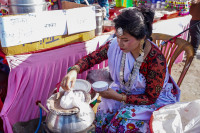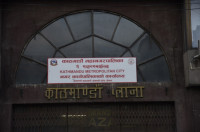Thu, Jan 1, 2026
Food
At this Dhulikhel institution, dal-bhat reigns supreme
Chapro serves its dal-bhat to all manner of customers, from daily wage labourers to businesspersons, and it has no pretensions of being Thakali..jpg&w=900&height=601)
bookmark
For those who take names seriously, Chapro, which means a temporary shed in Nepali, is likely to conjure up images of a make-shift barebones roadside eatery. But Chapro is far from that. It’s a proper restaurant housed in a commercial complex. The story behind the restaurant’s choice of name goes something like this: Around 17 years ago, Shanti Tamang and her husband decided to start a restaurant. But without a lot of capital, they started a small roadside eatery, a literal chapro, not far from where the current iteration is located. It had a few stools for customers to sit on and tarpaulin for a roof. What the place lacked in aesthetics, it made up with food—which was mainly dal, bhat, tarkari and masu. Since the restaurant didn’t have a name, diners started calling it chapro and the name stuck. Beginning with its humble roots, Chapro has always catered to a diverse clientele—from daily wage labourers and nearby salaried workers to tourists and business people.
Around five years ago, Chapro shed it’s temporary tarpaulin and moved into a more permanent, and much fancier, new space. Everything else has remained the same. Its continuing popularity is testament to a successful transition.
The first time I ate at Chapro was a year ago, on a hot summer afternoon. The place was packed to the rafters with doctors and nurses from the nearby Dhulikhel Hospital, drivers and travellers plying the Araniko Highway and BP Highway, along with some locals. I distinctly remember how good, and how cheap, the meal was. Chapro ended up becoming my go-to place in Dhulikhel.
On a recent warm winter afternoon, after spending hours hiking in the hills of Dhulikhel, I arrive at Chapro, hungry and tired. It is already 2:30 pm—which is way past Nepali lunchtime—but the restaurant still has plenty of people wolfing down dal-bhat-tarkari. There is also a group of motorcyclists from West Bengal noisily chomping down dal-bhat by the fistful and simultaneously sipping beer. A couple walks in just after I arrive and orders khana with masu without even asking for the menu. This establishment doesn’t do menus and it doesn’t serve the Nepali restaurant staple of momos, chow mein and fried rice. There’s dal-bhat and there’s masu-chiura. ![]()
But it’s the choice of vegetables that really makes the meal. All vegetables are procured from farmers in Chap Gaon, which is where the owners of the restaurant live. The restaurant pays the farmers the retail rate and buys whatever they have on offer, which shapes the menu of the day.
Today, there is potato-and-radish curry, which isn’t the most appealing looking thing. It is coated with abundant turmeric and other masalas, making it almost impossible to identify the radish from the potato. Both are cooked well. The pan-fried saag comes with deep-fried chopped and whole chillies. The blackened chillis do more than just add a splash of colour—they add heat to the otherwise dull spinach.
While the spinach and potato-and-radish curry do not really stand out, the dal, which is comfortingly thick, does. The fried cumin in the dal adds an earthy taste with a hint of nulliness and there is flotsam of caramelised onions on the surface, along with chopped deep-fried chillis and roasted cumin seeds, all of which do wonders to the yellow sea of dal. The onions add a slightly burnt taste and a mild sweetness to the dish, and the chillis add a wicked heat.
The winner, however, is the mutton curry. The meat is cooked to the point where it retains its springiness yet the meat breaks down without much effort. The meat, which pulls off the bone without much resistance, has wonderfully absorbed the broth’s complex flavours. According to the owner, the meat curry is prepared by her mother with a mixture of 12 herbs and spices, including cardamom, cloves, bay leaves, which are first sun-dried and then ground.
The chicken curry doesn’t quite live up to the high standards set by the mutton. Some of the chicken chunks are slightly overcooked, resulting in dry, rubbery meat. But just like the mutton, the chicken broth is excellent and the staff serves a seemingly unlimited quantity of broth, which is not the case at many of Kathmandu’s dal-bhat restaurants. The meat curries are so popular that the restaurant uses an average of 20 kgs of mutton and 12 kgs of chicken every day.
By the time, I am done with my meal, its already half past three in the afternoon. The last of the customers have left and the restaurant’s staff is busy sweeping and mopping up the floor. Between 4pm and 6pm, the staff gets busy preparing the evening meals and during that time, the restaurant sells khaja sets.
Just as I am about to depart, a group of four customers comes in, all Dhulikhel locals, and orders four mutton khaja sets. Within minutes, the khaja sets arrive and one of the diners tells me that I should try the khaja set too. But I am too full from the dal-bhat, maybe next time I am in Dhulikhel, it will be a mutton khaja set at this storied institution.
Hantakali
Published at : December 27, 2019
Updated at : December 27, 2019 07:59
Kathmandu might have Jimbu Thakali and Tukuche Thakali Kitchen but the neighbouring town of Dhulikhel boasts a dal-bhat joint that is almost as popular. Located right in the centre of town, Chapro, touted as Dhulikhel’s most popular eatery for dal-bhat, serves an average of 200 plates of dal, bhat, tarkari every single day. The restaurant’s popularity has even earned it a spot on Lonely Planet’s list of restaurants to eat at in Dhulikhel.
For those who take names seriously, Chapro, which means a temporary shed in Nepali, is likely to conjure up images of a make-shift barebones roadside eatery. But Chapro is far from that. It’s a proper restaurant housed in a commercial complex. The story behind the restaurant’s choice of name goes something like this: Around 17 years ago, Shanti Tamang and her husband decided to start a restaurant. But without a lot of capital, they started a small roadside eatery, a literal chapro, not far from where the current iteration is located. It had a few stools for customers to sit on and tarpaulin for a roof. What the place lacked in aesthetics, it made up with food—which was mainly dal, bhat, tarkari and masu. Since the restaurant didn’t have a name, diners started calling it chapro and the name stuck. Beginning with its humble roots, Chapro has always catered to a diverse clientele—from daily wage labourers and nearby salaried workers to tourists and business people.
Around five years ago, Chapro shed it’s temporary tarpaulin and moved into a more permanent, and much fancier, new space. Everything else has remained the same. Its continuing popularity is testament to a successful transition.
The first time I ate at Chapro was a year ago, on a hot summer afternoon. The place was packed to the rafters with doctors and nurses from the nearby Dhulikhel Hospital, drivers and travellers plying the Araniko Highway and BP Highway, along with some locals. I distinctly remember how good, and how cheap, the meal was. Chapro ended up becoming my go-to place in Dhulikhel.
On a recent warm winter afternoon, after spending hours hiking in the hills of Dhulikhel, I arrive at Chapro, hungry and tired. It is already 2:30 pm—which is way past Nepali lunchtime—but the restaurant still has plenty of people wolfing down dal-bhat-tarkari. There is also a group of motorcyclists from West Bengal noisily chomping down dal-bhat by the fistful and simultaneously sipping beer. A couple walks in just after I arrive and orders khana with masu without even asking for the menu. This establishment doesn’t do menus and it doesn’t serve the Nepali restaurant staple of momos, chow mein and fried rice. There’s dal-bhat and there’s masu-chiura.
.JPG)
Once the orders are placed, the dal-bhat arrives quickly in shiny brass plates. The khana isn’t Thakali-style, and it has no pretensions of such. The content is simple—a mound of rice, fresh tomato chutney, a vegetable curry, a jungle of spinach with a glossy sheen, and a thick murky yellow dal in a steel bowl. There is a choice of meat—chicken or mutton curry.
But it’s the choice of vegetables that really makes the meal. All vegetables are procured from farmers in Chap Gaon, which is where the owners of the restaurant live. The restaurant pays the farmers the retail rate and buys whatever they have on offer, which shapes the menu of the day.
Today, there is potato-and-radish curry, which isn’t the most appealing looking thing. It is coated with abundant turmeric and other masalas, making it almost impossible to identify the radish from the potato. Both are cooked well. The pan-fried saag comes with deep-fried chopped and whole chillies. The blackened chillis do more than just add a splash of colour—they add heat to the otherwise dull spinach.
While the spinach and potato-and-radish curry do not really stand out, the dal, which is comfortingly thick, does. The fried cumin in the dal adds an earthy taste with a hint of nulliness and there is flotsam of caramelised onions on the surface, along with chopped deep-fried chillis and roasted cumin seeds, all of which do wonders to the yellow sea of dal. The onions add a slightly burnt taste and a mild sweetness to the dish, and the chillis add a wicked heat.
The winner, however, is the mutton curry. The meat is cooked to the point where it retains its springiness yet the meat breaks down without much effort. The meat, which pulls off the bone without much resistance, has wonderfully absorbed the broth’s complex flavours. According to the owner, the meat curry is prepared by her mother with a mixture of 12 herbs and spices, including cardamom, cloves, bay leaves, which are first sun-dried and then ground.
The chicken curry doesn’t quite live up to the high standards set by the mutton. Some of the chicken chunks are slightly overcooked, resulting in dry, rubbery meat. But just like the mutton, the chicken broth is excellent and the staff serves a seemingly unlimited quantity of broth, which is not the case at many of Kathmandu’s dal-bhat restaurants. The meat curries are so popular that the restaurant uses an average of 20 kgs of mutton and 12 kgs of chicken every day.
By the time, I am done with my meal, its already half past three in the afternoon. The last of the customers have left and the restaurant’s staff is busy sweeping and mopping up the floor. Between 4pm and 6pm, the staff gets busy preparing the evening meals and during that time, the restaurant sells khaja sets.
Just as I am about to depart, a group of four customers comes in, all Dhulikhel locals, and orders four mutton khaja sets. Within minutes, the khaja sets arrive and one of the diners tells me that I should try the khaja set too. But I am too full from the dal-bhat, maybe next time I am in Dhulikhel, it will be a mutton khaja set at this storied institution.
Chapro: Rs250-280 pp
Food: ★★
Ambience: ★★
Value: ★★★★
Most Read from Food
Editor's Picks
Nepal’s workplaces still fail new mothers
When will Nepali-origin professional footballers in Europe play for Nepal?
‘Like a dream’: Labourer from Dalit community secures full MBBS scholarship
Why Nepal is launching a system to track foreign nationals
Nepal achieves global vaccine target, seven years ahead of schedule
E-PAPER | January 01, 2026
×




 7.12°C Kathmandu
7.12°C Kathmandu









%20(1).jpg&w=300&height=200)

